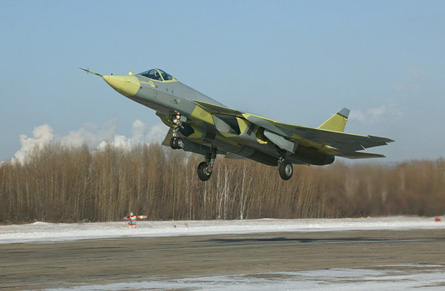Russia's Sukhoi PAK-FA stealthy fifth-generation fighter is showing promise in its test-flight programme and will probably fly at Moscow's MAKS air show in August, says United Aircraft chief Mikhail Pogosyan.
"There is no aircraft in the world that doesn't undergo certain modifications based on the test [programme] results. The most successful only require minor modifications to support systems. Our experience so far gives us confidence that we will avoid significant problems. The past year gives us sound grounds to say we are moving in the right direction.
"We're quite happy and pleased with the course of testing."
Two prototypes are now flying at the Gromov flight test centre at Zhukovsky, a suburb southeast of Moscow.
 |
|---|
© Sukhoi |
Russia has a requirement for 150 or more of the aircraft, which carries the internal Sukhoi designation of T-50, to enter service from 2015-16. India plans to buy between 200 and 250 of a modified design under the designation Fifth Generation Fighter Aircraft.
Pogosyan denies that New Delhi is simply providing funding for Russian designers to produce a modified aircraft for the Indian air force's requirements.
He says India is bringing its own engineering input to the joint variant, although he declines to detail New Delhi's contribution beyond saying it covers aspects of airframe design, software development and other systems.
Pogosyan points to previous co-operation between the two countries in which Indian engineers helped to develop the capabilities of the Sukhoi Su-30MKI in Indian service as evidence of India's engineering expertise.
Asked for his professional opinion on China's J-20 stealth fighter unveiled in January, Pogosyan says: "You'd better ask the Chinese."
Pressed on whether he feels the aircraft is a genuine prototype or merely a technology demonstrator, he says: "China's aviation industry has achieved really significant progress. But on the other hand, to create a really competitive product is time-consuming, demands significant experience in the engineering field and experienced human resources."
Source: Flight Daily News
















